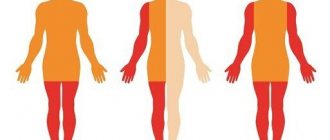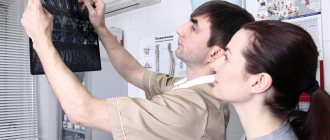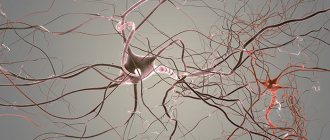Toxic polyneuropathy is a syndrome that occurs due to damage to peripheral nerves by external or internal toxins. It develops as a result of the direct toxic effect of poisons on various structures of the central and peripheral nervous system (exogenous toxicosis) or as a result of damage to parenchymal organs and body systems responsible for detoxification (endogenous toxicosis).
Neurologists at the Yusupov Hospital provide complex therapy for toxic polyneuropathies, which includes:
- removing toxins from the body using infusions of blood substitutes that have a detoxifying effect;
- impact on the mechanisms of development of damage to the nervous system;
- reduction and reversal of symptoms of the disease.
To determine the cause of peripheral nerve damage, toxicology tests are performed. Changes in the patient’s body are determined using modern laboratory tests. Neurophysiologists perform electroneuromyography, which makes it possible to determine the location and extent of damage to nerve fibers.
Candidates and doctors of medical sciences, doctors of the highest category have an individual approach to the choice of treatment method for the patient. Leading neurologists and toxicologists use modern medications to treat patients with polyneuropathy. At the Yusupov Hospital, patients suffering from toxic polyneuropathy of the lower extremities undergo plasmapheresis.
Causes and mechanisms of development of toxic polyneuropathy
The developing toxic process is based on damage to any structural element of the nervous system by modifying energy and plastic metabolism, disrupting the generation and conduction of nerve impulses along excitable membranes, and signal transmission at synapses. All known poisons have a neurotoxic effect. Any acute intoxication is accompanied by dysfunction of peripheral nerves.
The nervous system is affected by many narcotic substances and industrial poisons:
- metallic mercury;
- arsenic compounds;
- manganese;
- tetralead;
- carbon disulphide.
Nerve fibers are involved in the pathological process during intoxication with many chemicals: lead, benzene and its homologues, fluorides, acrylates, carbon monoxide, chromium. The nature of damage to the nervous system depends on the chemical structure of the substance, the total dose received by the body, and the methods of entry of these substances into the body.
Toxins can selectively affect individual structural elements of the nervous system:
- mercury compounds, manganese, aluminum, glutamate, cyanide, thallium damage neurons and dendrites (branched processes of neurons);
- tetrodotoxin, saxitoxin, carbon disulfide, colchicine have a toxic effect on axons (long cylindrical processes of a nerve cell);
- nicotine, organophosphorus compounds, carbamates, bicyclophosphates, norborian, picrotoxicin, cannabinol diethylamide disrupt synapses (points of contact between two neurons or between a neuron and a cell receiving a signal;
- hexachlorophenol, triethyltin, tellurium destroy the myelin sheath and myelinating cells.
Specific points of application of most toxic substances have not been identified. The selectivity of the toxic effect is relative. As the dose of poisons increases, the damage becomes less selective.
Diffuse damage to neurons of the central nervous system is caused by organophosphorus substances, organic solvents, manganese, and thallium. Some poisons preferentially affect the basal ganglia (striatum, globus pallidus, and cerumenus). Arsenic, mercury, thallium, and carbon disulfide have a toxic effect on sensitive nerve fibers of peripheral nerves. Lead, thallium, arsenic, and mercury disrupt the functions of motor nerve fibers of peripheral nerves. The autonomic ganglia and dorsal roots of the spinal cord are affected by methylmercury.
Diagnostic principles
The diagnosis is based on objective symptoms, results of laboratory and instrumental examinations and anamnesis. In addition to the mandatory examination by a therapist and neurologist, the following are indicated:
- general clinical analysis of blood and urine;
- biochemical blood test with determination of glucose, ALT, AST, bilirubin, urea, creatinines and electrolytes;
- according to indications: analysis to determine immunospecific status, neurospecific factors;
- CT, MRI, angiography;
- specific tests to detect heavy metals and narcotic substances in the body.
If symptoms indicate damage to internal organs, additional research or consultation with specialized specialists may be required. Differential diagnosis is carried out with other forms of encephalopathies and neurodegenerative diseases.
Symptoms of toxic polyneuropathy
Depending on the conditions of exposure, the structure of the toxic substance, and its neurotoxic potential, pathological processes in polyneuropathy occur acutely, subacutely or chronically. A manifestation of an acute neurotoxic effect is a violation of the conduction of nerve impulses along motor and autonomic fibers and blockade or distortion of incoming sensory information.
In polyneuropathies - clinical syndromes characterized by diffuse damage to peripheral nerve fibers, the unit of damage is the fibers that are part of various nerves. The likelihood of damage depends on their length, caliber, and metabolic rate. Clinical manifestations of polyneuropathies - widespread, symmetrical, usually distal and progressive lesions - vary widely. They differ in the rate of progression, severity of symptoms, the ratio of sensory and motor disorders, and the presence of irritation symptoms.
Toxic polyneuropathy of the lower extremities begins with paresthesia (a crawling sensation) and pain in the feet, then in the hands. The intensity of the pain quickly becomes unbearable. In some patients, the tip of the nose and ears are involved in the process. They are worried about pain in the teeth and itching of the gums in the upper jaw, and short-term nasal congestion.
The process of polyneuropathy spreads from bottom to top: on the lower extremities - to the knee joints, on the upper extremities - to the shoulder girdle. First, damage to the lower extremities is detected. Neurologists diagnose the extinction of the Achilles reflex and sensory disturbances in the form of “socks”. Then flaccid paralysis develops with gradual extinction of reflexes. Knee and abdominal reflexes are preserved, sometimes strengthened, and symmetrical. Patients develop a fear of pain from touching objects, which leads to a forced position of their legs and arms. The following symptoms are noted:
- pain upon palpation of the skin of the extremities and upon pressing on the exit points of the second branch of the trigeminal nerve;
- hyperesthesia (increased sensitivity of the skin) like high socks and stockings;
- impairment of proprioceptive sensitivity (sense of the position of parts of one’s own body relative to each other and in space);
- decreased muscle tone and strength;
- hypotrophy (loss of mass) of the muscles of the limbs.
As the disease progresses, swelling of the feet and lower third of the legs and hands appears. Some patients with toxic polyneuropathy develop trophic ulcers and skin irritation due to the fact that, in an attempt to relieve pain, they take cold water baths for the extremities. Other patients experience atrophic changes in the skin of the hands. Sometimes the epidermis of the hands and feet exfoliates, hyperkeratosis (excessive growth of the stratum corneum of the epidermis) and mosaic pigmentation. Appetite decreases, sleep is disturbed, and severe neurosis develops. There is pallor of the skin of the face and moderate tachycardia (increased heart rate).
Peripheral neuropathy is sometimes caused by drugs:
- chloramphenicol;
- colistin;
- phenelzine;
- ergotamine.
Mixed sensory-motor polyneuropathy develops as a result of uncontrolled intake of ethambutol, isoniazid, metronidazole, streptomycin, chlorpropamide. Motor polyneuropathy is mainly caused by amphotericin B, sulfonamides, amitriptyline, cimetidine, and tetanus toxoid. Neurotoxicity is one of the side effects of drugs for the treatment of malignant neoplasms and immunosuppressants. Polyneuropathies often occur in acute and chronic intoxication with metals and salts of arsenic, tin, thallium, and zinc vapor.
Neurologists at the Yusupov Hospital make a diagnosis of toxic polyneuropathy based on a characteristic medical history, clarification of the cause of chronic intoxication, and neurological examination data. An electroencephalogram, ECG, Doppler study of cerebral vessels are performed and the diagnosis is confirmed by the results of electroneuromyography.
Diabetic neuropathy - symptoms, syndromes, types
Diabetic neuropathy is classified in several ways. A number of authors distinguish four main types of diabetic neuropathy:
— peripheral neuropathy
- one of the most common types, in which there is damage to the nerve fibers of the extremities, and the lower extremities are affected more often;
— autonomic neuropathy
- in which the functioning of many internal organs is disrupted - the heart, stomach, intestines, and sexual dysfunction develops;
— proximal neuropathy
- characterized by severe pain in the thighs, buttocks and hip joints;
— focal neuropathy
- in which local damage to individual nerve fibers occurs.
There is a classification of diabetic neuropathy, which is based on the principle of identifying syndromes with characteristic clinical manifestations and course. According to it, diffuse neuropathy
(affecting all nerve fibers) and
focal neuropathy
(affecting certain areas of the human body).
The prevalence of diffuse neuropathy is much higher, it progresses rapidly and is often asymptomatic. It includes autonomic diabetic neuropathy
and
distal symmetric sensorimotor diabetic polyneuropathy
.
Focal neuropathy is less common and occurs acutely, losing its clinical manifestations over time. It includes cranial neuropathy, radiculopathy, plexopathy, mononeuropathy.
Treatment of toxic polyneuropathy
Treatment of toxic polyneuropathy of the lower extremities involves eliminating the toxic effects of the causative factor. If we are talking about endogenous poisoning, then endocrinologists prescribe drugs for the treatment of diabetes mellitus, diseases of the thyroid gland, liver and kidneys.
Doctors at the Neurology Clinic provide complex therapy for toxic polyneuropathy of the lower extremities in several areas:
- etiotropic – aimed at removing toxic substances from the body and treating the disease that caused chronic intoxication;
- pathogenetic – influencing the mechanisms of damage to peripheral nerves;
- symptomatic – relief of pain and other signs of the disease;
- restorative - restoring the myelin sheath of the nerves of the lower extremities and conducting impulses through them.
For acute toxic polyneuropathy, plasmapheresis is performed at the Yusupov Hospital. Vitamins have a direct neurotropic effect. They are necessary for the normal functioning of nervous tissue. Thiamine (vitamin B1) maintains the protein, carbohydrate and amino acid balance of the nerve cell and is a modulator of neuromuscular transmission. Pyridoxine (vitamin B6) affects the structure and function of nerve fibers, regulates amino acid metabolism and prevents the accumulation of neurotropic poisons. Vitamin B12 (cyanocobalamin) promotes regeneration (restoration) of nervous tissue. The optimal dosage form of B vitamins for toxic polyneuropathies is Neurovitan. It contains high dosages of all three B vitamins.
Alpha lipoic acid normalizes metabolic processes, helps compensate for polyneuropathy, and normalizes the functions of antioxidant protection. Berlition®, due to its optimal concentration of alpha-lipoic acid, improves endoneurial blood flow, trophism and function of neurons, and helps eliminate symptoms of polyneuropathy such as burning, pain, and numbness of the lower extremities. The versatility of the drug allows neurologists to prescribe it for the treatment of toxic polyneuropathy of the lower extremities.
To maintain muscle tone, rehabilitation therapists conduct courses of massage and physical therapy, electrical stimulation of the spinal cord and magnetic therapy. You can undergo a course of complex therapy for toxic polyneuropathy at the neurology clinic by first making an appointment by calling the Yusupov Hospital, where they use modern methods for removing toxic substances from the body. Neurologists use modern medications that are highly effective and have minimal side effects.
A set of methods for diagnosing diabetic neuropathy
The list of diagnostic methods for diabetic neuropathy is directly related to the form of neuropathy the patient presented with. Therefore, at the initial consultation, anamnesis and complaints are carefully collected, based on which the endocrinologist or diabetologist involves other specialists in the study.
All patients need to determine the level of sugar, insulin and glycosylated hemoglobin in the blood; examination of the legs is mandatory to identify wounds, trophic ulcers, fungal infections, calluses, etc.
Neurological examination of patients with diabetic neuropathy includes electromyography and electroneurography, assessment of reflexes and the level of perception of all senses.
If there are symptoms of damage to the digestive tract, it would not be superfluous to do an ultrasound examination of the abdominal organs, radiography of the stomach, and esophagogastroduodenoscopy. If the patient has complaints from the genitourinary system, it is necessary to conduct a general urine test, ultrasound of the kidneys and bladder with determination of residual urine volume, cystoscopy and urography.










